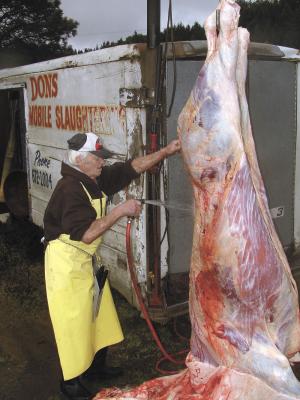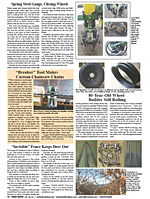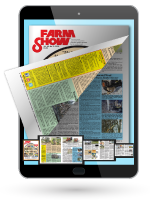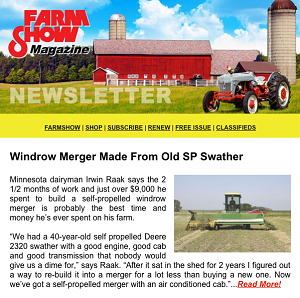Backyard Butcher Goes To The Meat
 ✖  |
Don Livermore doesn't sit in town waiting for someone to bring in an animal for butchering. He takes his rig to the farm and butchers right in the backyard. In 90 min. he can kill, clean, quarter and load a full size head of beef. Within 2 to 3 hrs. of the animal going down, it's being cut up at a local meat cutting shop.
"It's just a job, and someone has to do it," says Livermore, who's been doing "it" for more than 40 years. In fact, his slaughter truck is 40 years old.
Livermore started his business in 1972 and charged $5 an animal. Today he charges $65 and slaughters an average of about 400 head of sheep and beef a year. His business was interrupted recently, however, when Livermore had an accident on the racetrack. An avid stockcar racer at age 70, he broke his neck, but expects to be back at work û and on the racetrack û within a year.
Livermore's trade is dying out, he says. Demand has steadily dropped over the past 10 years or so. For many years he never slaughtered fewer than 1,000 animals, reaching a peak of 1,300 in 1996. He recalls when there were as many as 6 mobile slaughter trucks working the roads of southwestern Ore. Today there are only three.
"Some farms where I used to butcher now have hundreds of houses sitting on them," says Livermore. "I don't think business will ever get back to what it used to be. Many people no longer have money to buy a half or quarter at a time. They've learned to live on hamburger from the store."
What hasn't changed is how he does the job. Once the animal has been put down (hopefully with a single bullet), he skins it, most of it on the ground. Then an electric hoist on the truck is used to lift the carcass to finish the skinning and remove the organs and offal. A reciprocating saw splits the carcass in half and then into quarters, which are hoisted onto the truck.
When Livermore started out in the business, he spent about $12,000 on a van and fitted it with a stainless steel interior for hauling meat. A separate small stainless steel room was installed behind the driver's compartment. It holds four 55-gal. drums to hold hides and offal. Livermore salts and sells the hides, while the offal goes to a landfill. He also installed a potable water supply tank in the truck. Livermore estimates a new truck would set him back around $60,000. He has no plans to buy a new one, says his wife Jayn.
"I think he'll keep doing it until he can't get up in the truck anymore or it gives out," she says. "Guys are betting on which one is going to give up first."
Contact: FARM SHOW Followup, Don's Mobile Slaughtering, 374 Buckhorn Rd, Roseburg, Ore. 97470 (ph 541 672-1004; no19racerlady@yahoo.com).

Click here to download page story appeared in.
Click here to read entire issue
Backyard Butcher Goes To The Meat LIVESTOCK Miscellaneous Don Livermore doesn t sit in town waiting for someone to bring in an animal for butchering He takes his rig to the farm and butchers right in the backyard In 90 min he can kill clean quarter and load a full size head of beef Within 2 to 3 hrs of the animal going down it s being cut up at a local meat cutting shop
It s just a job and someone has to do it says Livermore who s been doing it for more than 40 years In fact his slaughter truck is 40 years old
Livermore started his business in 1972 and charged $5 an animal Today he charges $65 and slaughters an average of about 400 head of sheep and beef a year His business was interrupted recently however when Livermore had an accident on the racetrack An avid stockcar racer at age 70 he broke his neck but expects to be back at work û and on the racetrack û within a year
Livermore s trade is dying out he says Demand has steadily dropped over the past 10 years or so For many years he never slaughtered fewer than 1 000 animals reaching a peak of 1 300 in 1996 He recalls when there were as many as 6 mobile slaughter trucks working the roads of southwestern Ore Today there are only three
Some farms where I used to butcher now have hundreds of houses sitting on them says Livermore I don t think business will ever get back to what it used to be Many people no longer have money to buy a half or quarter at a time They ve learned to live on hamburger from the store
What hasn t changed is how he does the job Once the animal has been put down hopefully with a single bullet he skins it most of it on the ground Then an electric hoist on the truck is used to lift the carcass to finish the skinning and remove the organs and offal A reciprocating saw splits the carcass in half and then into quarters which are hoisted onto the truck
When Livermore started out in the business he spent about $12 000 on a van and fitted it with a stainless steel interior for hauling meat A separate small stainless steel room was installed behind the driver s compartment It holds four 55-gal drums to hold hides and offal Livermore salts and sells the hides while the offal goes to a landfill He also installed a potable water supply tank in the truck Livermore estimates a new truck would set him back around $60 000 He has no plans to buy a new one says his wife Jayn
I think he ll keep doing it until he can t get up in the truck anymore or it gives out she says Guys are betting on which one is going to give up first
Contact: FARM SHOW Followup Don s Mobile Slaughtering 374 Buckhorn Rd Roseburg Ore 97470 ph 541 672-1004; no19racerlady@yahoo com
To read the rest of this story, download this issue below or click
here to register with your account number.







